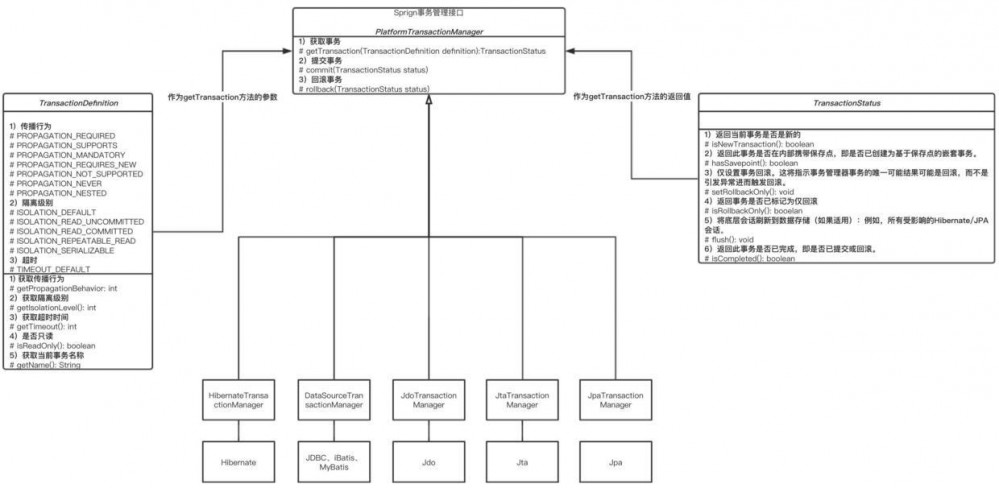Spring事务管理
一、Spring事务接口与ORM对应关系
Spring是web框架,它其实并不与MySQL数据库进行直连,一般都是通过ORM层框架,诸如 JDBC 、 iBatis 、 MyBatis 、 Hibernate 、 JPA 等,与数据库进行连接的,而事务的管理都是交由各持久层框架自行处理的,Spring只是出具了事务管理器接口 org.springframework.transaction.PlatformTransactionManager 及不同的 PlatformTransactionManager 实现类,为不同的持久层框架提供对应的实现类,将管理事务的职责下放到各持久层框架,交由持久层框架处理。
-
org.springframework.jdbc.datasource.DataSourceTransactionManager:使用JDBC、iBatis、MyBatis进行持久化数据时使用 -
org.springframework.orm.hibernate5.HibernateTransactionManager:使用Hibernate5版本进行持久化数据时使用 -
org.springframework.orm.jpa.JpaTransactionManager:使用JPA进行持久化数据时使用 -
org.springframework.jdo.JdoTransactionManager:当持久化机制是jdo时使用 -
org.springframework.transaction.jta.JtaTransactionManager:使用一个JTA实现来管理事务,在一个事务跨越多个资源时必须使用 - 等等…

Spring事务类图
二、Spring事务的开启方式
编程式:
我不知道该怎么称呼它,因为自从工作以来,也没有遇到过,但是不代表人家不存在,也许很老的项目里依然存在。主要依靠手动处理来管理事务,对业务代码有侵入性。
1)编程式,可以使用 TransactionTemplate 或者直接使用底层的 PlatformTransactionManager 。对于编程式事务管理,Spring推荐使用 TransactionTemplate
代码不做展示,太冗余了
声明式:
声明式事务本质是建立在AOP基础之上的,在代理类实例里拦截目标方法,在方法执行前,开启或者加入一个事务,执行完毕或者发生异常后,根据具体情况进行提交或者回滚。
相比较编程式事务,其最大的特点就是对业务代码没有侵入性,只需在配置文件中对事务进行配置管理(或者基于 @Transactional 注解的方式)即可,这样就可以将业务代码和事务管理隔离开。
1) TransactionProxyFactoryBean 声明式事务管理
此方式是最传统,配置文件最臃肿、难以阅读的一种方式
代码不做展示,太冗余了
2) @Transactional 注解事务管理
基于注解的事务管理,在需要开启事务的类或方法上添加 @Transactional ,这种方式比较灵活,随用随加,但是容易到处乱用,凌乱不堪。更偏重灵活性。
<!-- 开启注解管理事务 --> <tx:annotation-driven transaction-manager="transactionManager"/> 复制代码
3) Aspectj AOP 配置事务管理
<!-- 事务AOP -->
<aop:config>
<!-- pointcut:切入点 aop:advisor 适配器,是要注入的方法和pointcut连接的桥梁 -->
<aop:advisor pointcut="execution(* cn.x.x..*.service..*.*(..))" advice-ref="txAdvice" />
</aop:config>
<!-- 需要注入的方法,可以使用通配符进行匹配 -->
<tx:advice id="txAdvice" transaction-manager="transactionManager">
<tx:attributes>
<tx:method name="get*" isolation="REPEATABLE_READ" propagation="REQUIRED" read-only="true" />
<tx:method name="insert*" isolation="REPEATABLE_READ" propagation="REQUIRED" rollback-for="Exception"/>
<tx:method name="update" isolation="REPEATABLE_READ" propagation="REQUIRED" rollback-for="Exception"/>
<tx:method name="delete*" isolation="REPEATABLE_READ" propagation="REQUIRED" rollback-for="Exception"/>
</tx:attributes>
</tx:advice>
<bean id="transactionManager" class="org.springframework.jdbc.datasource.DataSourceTransactionManager">
<property name="dataSource" ref="dataSource" />
</bean>
复制代码
三、事务的配置信息
基于`Aspectj AOP配置事务管理`进行配置讲解
首先重温一下:在上一篇 《MySQL事务及隔离级别》 里,我们介绍了MySQL事务如果没有设置隔离级别,并发可能产生的几个安全问题:
- 脏写
- 脏读
- 不可重复读
- 幻读
一些大佬,对此设计出了数据库事务的隔离级别,来确保根据具体情况,适时适当选用对应的策略,这种策略我们称之为 事务的隔离级别 ,如下:
- 读未提交 - 可能存在脏读、不可重复读、幻读
- 读已提交 - 可能存在不可重复读、幻读
- 可重复读 - 可能存在幻读(设计MySQL的大叔已经可以确保,在这个级别不出现幻读的情况)
- 串行化 - 排队吃果果 很安全,但是真的影响效率
属性设置
<tx:method
name="insert*"
isolation="REPEATABLE_READ"
propagation="REQUIRED"
rollback-for="Exception"
read-only="false"
no-rollback-for="RuntimeException"
timeout="xxx"/>
复制代码
1、name 与事务属性关联的方法名
可以使用通配符(*)关联一批相同事务属性的方法
2、isolation 隔离级别
默认值:DEFAULT
- DEFAULT:使用数据库默认的事务隔离级别
- READ_UNCOMMITTED:读未提交
- READ_COMMITTED:读已提交
- REPEATABLE_READ:可重复读
- SERIALIZABLE: 串行化
3、propagation 事务传播行为
默认值:REQUIRED
- MANDATORY:该方法必须在事务中运行,如果当前事务不存在,则抛出异常
- NESTED:如果当前已经存在一个事务,则
新建一个嵌套事务,该事务可以有多个回滚点,如果没有事务,则按REQUIRED属性执行,此方法对应的事务回滚不会对外部(嵌套)事务造成影响,但是外部事务回滚会影响内部事务。 - NEVER:该方法不会在事务中运行,否则抛出异常。
- NOT_SUPPORTED:此方法不需要事务,如果调用方处于一个事务中,那么该事务将被挂起,直到此方法执行完毕,被挂起的事务才恢复执行。
- REQUIRED:方法需要在事务中运行,如果运行时,该方法已经处于一个事务中,那么将加入到这个事务,否则自己创建一个事务。
- REQUIRED_NEW:当调用该方法时,无论此方法是否已经处在一个事务中,都会为重新创建一个新的事务,如已经存在一个事务了,那么该事务将被挂起,然后创建新的事务,直到此方法执行结束(事务被提交或者回滚),原先的事务才被执行。如果内部事务发生回滚,会影响已经挂起的事务。
- SUPPORTS:调用方在事务中,那么此方法也加入到事务中,如果没有没有事务,则非事务的方式执行。
4、timeout 超时
默认值 -1
挺有意思的一个小东西,如果项目里使用 MyBatis ,即使设置了超时时间,也是没有任何效果的,暂时的解决办法是,使用MyBatis的超时设置或者使用 JdbcTemplate 进行数据库的操作。
5、read-only 只读
默认值 false
事务是否只读
如果当前事务是只读,且在事务内进行增、删、改操作,则会抛出异常(Cannot execute statement in a READ ONLY transaction。)
只读属性有什么用?6、rollback-for 触发回滚的异常
可以有多个,以逗号相隔,如果是自定义异常,则需要类的完全限定名,我查阅很多资料,发现大家都趋向于下面的结论:
如果发生的是检查时异常,那么事务不会自动回滚,如果是运行时异常,事务会自动回滚
经过实际测试后发现,如果我们指定 rollback-for="Exception" ,那么,抛出检查型异常一样可以触发事务的回滚。
官方文档给出的信息是:
默认情况下,检查时异常不会引起事务回滚,但是RuntimeException及其子类会引起事务回滚
7、no-rollback-for 不触发回滚的异常
和上面的类似,请自我揣摩~
四、野外拓展?
声明式事务是建立在AOP基础上的,我们以下面的代码作为蓝本:
假设事务的隔离级别是RR(Repeatable-Read)
配置信息:
<!-- 事务AOP -->
<aop:config>
<!-- pointcut:切入点 aop:advisor 适配器,是要注入的方法和pointcut连接的桥梁 -->
<aop:advisor pointcut="execution(* x.x..*.service..*.*(..))" advice-ref="txAdvice" />
</aop:config>
<!-- 需要注入的方法,可以使用通配符进行匹配 -->
<tx:advice id="txAdvice" transaction-manager="transactionManager">
<tx:attributes>
<tx:method name="get*" isolation="REPEATABLE_READ" propagation="REQUIRED" read-only="true" />
<tx:method name="insert*" isolation="REPEATABLE_READ" propagation="REQUIRED" rollback-for="Exception"/>
</tx:attributes>
</tx:advice>
<bean id="transactionManager" class="org.springframework.jdbc.datasource.DataSourceTransactionManager">
<property name="dataSource" ref="dataSource" />
</bean>
复制代码
代码:
public interface StudentService {
List<Student> getStudents(String name);
void insertStudent(Student student);
deleteStudent(int id);
}
复制代码
@Service
public class StudentServiceImpl implements StudentService {
@Autowired
private StudentDao studentDao;
@Override
public List<Student> getStudents(String name) {
Map<String, Object> params = Maps.newHashMap();
params.put("name", name);
return studentDao.getStudents(params);
}
@Override
public void insertStudent(Student student) {
studentDao.insert(student);
}
@Override
public void deleteStudent(int id) {
studentDao.delete(id);
}
}
复制代码
@RestController
@RequestMapping("/students")
public class StudentController {
@Autowired
private StudentService studentService;
@GetMapping("/test")
public void run() {
student.getStudents("张三");
Student student = Student.builder()
.id(1)
.name("张三")
.age(19)
.build();
student.insertStudent(student);
student.deleteStudent(student.getId());
}
}
复制代码
如上,StudentService 的 insert和get方法均开启了事务,但是deleteStudent方法没有开启事务。
问题:
1)在 deleteStudent() 里调用 insertStudent() ,试问, insertStudent() 是否开启事务?为什么?
还原代码:
@Service
public class StudentServiceImpl {
@Autowired
private StudentDao studentDao;
public void insertStudent(Student student) {
studentDao.insert(student);
}
public void deleteStudent(int id) {
// 删除逻辑代码
// 调用
insertStudent(student);
}
}
复制代码
答案:
不开启事务
解读:
① 当 StudentService.java 文件进行编译的时候,编译器会将 deleteStudent() 方法里的 insertStudent(student); 编译成 this.insertStudent(student);
② Controller层使用 @Autowired 注解进行 StudentService 的自动装配,但装配的实例并不是StudentServiceImpl类的实例,而是代理类的实例! 声明式事务是建立在AOP基础上的 ,而AOP的实现原理就是代理模式!所以我们在Controller层所调用的方法会被代理类拦截。
③ 在代理类的拦截方法内,如果发现要调用的目标类方法是要开启事务的,那么就会在调用目标类方法之前开启事务,在目标类方法执行完毕或者发生异常后,根据情况执行回滚或不执行回滚。回归正题,当代理类发现 deleteStudent() 没有开启事务的要求,那么代理类是不会开启事务的。
当我们在 deleteStudent() 里调用 insertStudent() 时,重点来了,jvm执行的是 this.insertStudent() 这个this是目标类本身,而不是代理类!但是事务的管理却在代理类里,所以, insertStudent() 方法并不会开启事务!
思考:
通过上面的解读,我们知道了service上的事务是由代理类来管理的,类似的像@Async异步标签,其实也是由代理类进行管理的,在service内部调用打上@Async标签的内部方法,异步也不会起作用的。
如果想调用内部方法,还想让事务/异步起作用,我们可以使用:xml配置方式暴露代理对象,通过代理对象AopContext.currentProxy()去调用方法。
xml:
<aop:aspectj-autoproxy
proxy-target-class="true"
expose-proxy="true"/>
复制代码
@Service
public class StudentServiceImpl {
@Autowired
private StudentDao studentDao;
public void insertStudent(Student student) {
studentDao.insert(student);
}
public void deleteStudent(int id) {
// 删除逻辑代码
// 调用
(StudentService) AopContext.currentProxy()).insertStudent(student);
}
}
复制代码
2)在 insertStudent() 里调用 deleteStudent() ,试问,如果 deleteStudent() 抛出运行时异常, insertStudent() 对应的操作是否回滚?为什么?
还原代码:
@Service
public class StudentServiceImpl {
@Autowired
private StudentDao studentDao;
public void insertStudent(Student student) {
studentDao.insert(student);
deleteStudent(student.getId());
}
public void deleteStudent(int id) {
studentDao.delete(id);
if (1 == 1)
throw new RuntimeException("测试回滚");
}
}
复制代码
答案:
回滚
解读:
① 当 StudentService.java 文件进行编译的时候, insertStudent(student) 方法里的 deleteStudent(); 变成 this.deleteStudent(); ,没毛病,继续。
② Controller层调用 insertStudent() 时,会开启事务,一样没毛病,继续。
③ 在 insertStudent() 里调用 this.deleteStudent() ,相当于将 deleteStudent() 的代码块加入到当前事务中,所以如果 deleteStudent() 抛出运行时异常,那么 insertStudent() 对应的操作会回滚。
- 本文标签: 测试 sql 代码 mybatis Property id Proxy 编译 安全 管理 REST JPA iBATIS Statement web 数据库 NSA list ACE AOP JDBC update tar IDE XML 删除 IO 传播行为 java 数据 实例 http ORM JVM 并发 spring https UI App src bean HashMap 类图 mysql db 配置 CTO build Service Mysql数据库 zab tab map 时间 dataSource Action 本质 适配器
- 版权声明: 本文为互联网转载文章,出处已在文章中说明(部分除外)。如果侵权,请联系本站长删除,谢谢。
- 本文海报: 生成海报一 生成海报二











![[HBLOG]公众号](https://www.liuhaihua.cn/img/qrcode_gzh.jpg)

